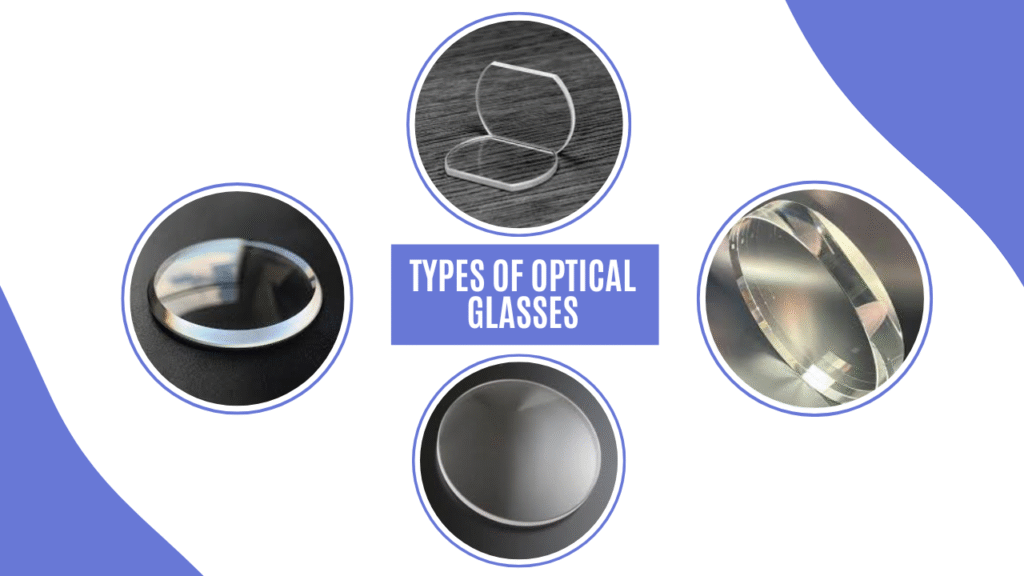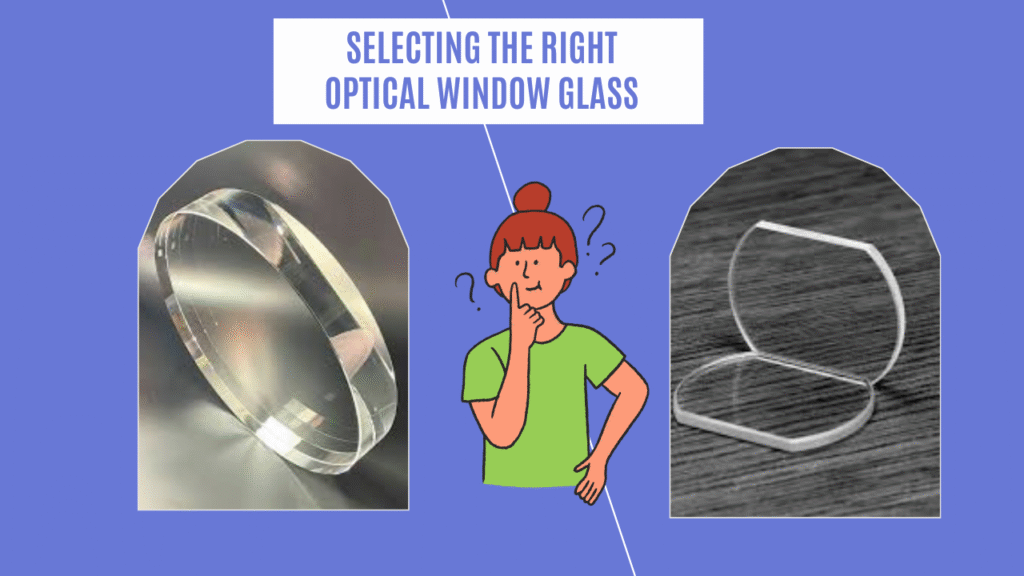Window glass plays an important role in more than just homes and buildings. In advanced technology and scientific industries, a special kind of glass known as optical window glass is used for tasks that require high clarity, precision, and durability. Unlike regular glass, optical glass is engineered to let light pass through with minimal distortion, making it essential in fields like aerospace engineering, biomedical imaging, laser systems, and defense optics.
These optical windows are crafted to withstand heat, pressure, and various environmental conditions, while still delivering accurate light transmission. Whether it’s filtering UV rays in a microscope or protecting sensors in a satellite, the quality of the glass can greatly impact performance.
In this guide, we’ll explore the different types of optical window glass, key material properties, practical applications, and simple tips to help you choose the right glass for your specific needs.
What Is Optical Window Glass?

Basic Definition & Optical Applications
Basic Definition
Optical window glass is a high-quality type of window glass made for devices that use light. It allows light to pass through clearly without bending, blocking, or changing it. This glass is made from materials like fused silica, BK7, or quartz, and is often coated to block UV or reduce glare. Unlike regular glass, it is designed for optical clarity, strength, and heat resistance, making it ideal for scientific and industrial use.
Optical Applications
Optical window glass is widely used in tools and systems that depend on precise light control. Here are some common applications:
- Microscopes
- Telescopes
- Laser systems
- Cameras and imaging devices
- Medical equipment
- Spectrometers
- Aerospace systems
- Defense optics
- UV and IR detectors
Why Choosing the Right Window Glass Matters?
Functionality vs Aesthetics
Functionality
Not all window glass is built the same. In scientific, industrial, or high-tech environments, the way glass performs is more important than how it looks. Optical window glass is made to deliver high clarity, strong durability, and excellent light transmission. It helps light pass through accurately without bending or distortion. This type of glass is engineered for heat resistance, optical quality, and long-lasting strength, making it ideal for demanding and sensitive applications.
Aesthetics
While some glass is chosen for its looks, like decorative or tinted glass in homes and offices, optical window glass focuses less on appearance. Its purpose is not to look good but to work well. In environments where precision matters, such as labs or laser systems, function always comes before design.
Performance Under Environmental Stress
High-quality window glass must perform reliably in tough environments. Whether exposed to extreme heat, freezing temperatures, humidity, or direct sunlight, the glass should maintain its optical clarity and structural strength. In many applications, especially in aerospace, medical devices, or outdoor optical systems, the glass must also resist scratches, thermal expansion, and UV radiation. Using durable materials like fused silica or sapphire glass helps ensure the window lasts longer, protects internal components, and continues to deliver accurate light transmission, even in challenging conditions.
Types of Window Glass Used for Optical Applications
Different applications require different types of window glass, each designed for specific light control, environmental resistance, and optical performance.

Fused Silica Glass (High UV & Thermal Stability)
Fused silica is ideal for high-temperature and ultraviolet (UV) environments. It offers excellent thermal resistance and optical clarity, making it perfect for laser optics, scientific instruments, and UV-sensitive systems.
BK7 (Borosilicate) Glass (Popular & Versatile)
BK7, a type of borosilicate glass, is widely used due to its affordability, transparency, and broad wavelength compatibility. It’s common in general-purpose optical systems, imaging devices, and lab equipment.
Sapphire Glass (Scratch-Resistant & Durable)
Sapphire glass is known for its exceptional hardness, scratch resistance, and mechanical strength. It’s ideal for harsh environments, military optics, and protective windows in rugged settings.
Quartz Glass (Extreme Optical Precision)
Quartz glass delivers high-purity light transmission and supports precise wavelength control. It’s used in metrology, semiconductor inspection, and other high-precision optical systems.
Colored or Filter Window Glass (Wavelength Control)
This type of window glass either blocks or transmits specific wavelengths of light, such as UV, IR, or visible colors. It’s essential in cameras, photographic filters, and spectral analysis tools.
Coated Optical Glass (UV, IR, Anti-Reflective Coatings)
Coated window glass includes anti-reflective coatings, UV filters, or infrared-reflective layers. These coatings enhance light transmission, reduce glare, and protect sensors in optical, medical, and defense applications.
Key Properties to Consider When Choosing Window Glass
Choosing the right window glass means looking at how it performs in real conditions. These key features help decide if the glass fits your optical needs.
Optical Clarity & Light Transmission
High-quality optical window glass should allow maximum light transmission without distortion. Clear glass helps your system deliver sharp and accurate results, especially in imaging or laser setups.
Scratch Resistance & Surface Quality
Durable glass surfaces resist scratches and maintain smoothness. This protects the optical path and ensures consistent visual and light-based performance over time.
UV, IR & Visible Light Transmission Range
Different types of optical glass manage UV, infrared (IR), and visible light differently. Choose glass that supports your desired wavelength range for specific optical tasks.
Mechanical Strength and Glass Thickness
Stronger glass can handle more pressure and heat. Picking the right glass thickness ensures safety, stability, and long-term use, especially in outdoor or high-stress environments.
Tips for Selecting the Right Optical Window Glass
The right window glass depends on your specific project. Here are some smart tips to help you choose wisely:

Understand Your Project Requirements
Know how and where the glass will be used—lab equipment, sensors, or medical tools. This guides the material and design needed.
Consider Light and Coating Needs
Decide if you need anti-reflective coatings, UV filters, or other treatments to improve performance and protect against glare or harmful rays.
Choose Between Standard vs Custom Glass
Off-the-shelf glass works for many jobs, but some tasks need custom-cut glass with special shapes, sizes, or coatings. Always explore custom glass options if needed.
Confirm Technical Specifications
Check if the glass can handle the temperature, pressure, and light exposure of your setup. Specs matter to avoid failure or damage.
Best Practices for Installation & Handling of Optical Glass
Proper handling keeps your optical window glass safe and effective. Follow these practices:
Cleaning Techniques to Protect Coatings
Use soft, lint-free cloths and distilled water to clean coated glass. Avoid abrasive cleaners that could scratch or strip protective layers.
Preventing Surface Damage During Handling
Handle glass with gloves to avoid fingerprints and scratches. Place it on soft surfaces and never let it touch hard or rough materials.
Storage Methods for Longevity
Store optical glass in a dry, cool, and dust-free area. Wrap it in soft materials and keep it out of direct sunlight or moisture.
Bottom Line
Choosing the right window glass is key to ensuring the performance, durability, and accuracy of your optical systems. From fused silica and BK7 to sapphire and quartz glass, each material serves a unique purpose—some resist heat, others offer better clarity or scratch resistance. Whether you require UV-blocking coatings, custom-cut dimensions, or specific light transmission ranges, matching your glass type to project needs is essential. Don’t overlook factors like glass thickness, surface quality, or proper handling and storage. With the right selection and care, your optical glass will deliver long-term reliability and clear results across applications—from labs to lasers and beyond.
FAQs
What is the difference between optical window glass and regular glass?
Optical window glass is ultra-clear, durable, and made for precise light transmission, while regular glass is used mostly for basic viewing or protection.
Can optical window glass be custom-made for specific devices or sizes?
Yes, many suppliers offer custom window glass with specific shapes, sizes, thicknesses, and coatings to match technical requirements.
What coatings are available for optical window glass, and how do they work?
Common coatings include anti-reflective, UV-blocking, and IR-reflective layers that reduce glare, protect against radiation, and improve performance.
Which type of optical window glass is best for high-temperature environments?
Fused silica and sapphire glass are ideal for extreme heat and UV exposure because they remain stable and clear under stress.
How do I maintain and clean optical window glass without damaging the coatings?
Use soft, lint-free cloths and gentle cleaning solutions. Avoid rough tools to protect the glass surface and any optical coatings.

